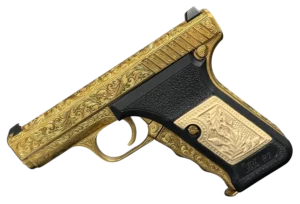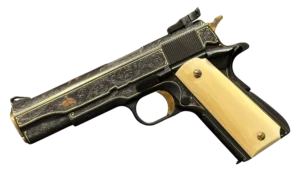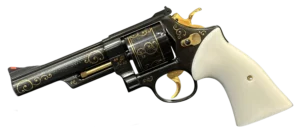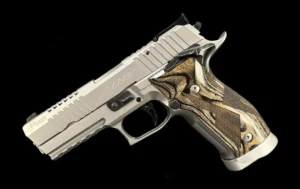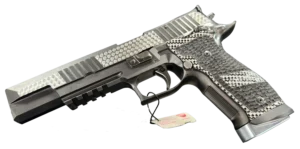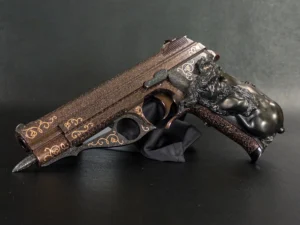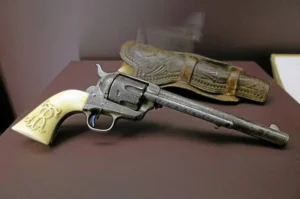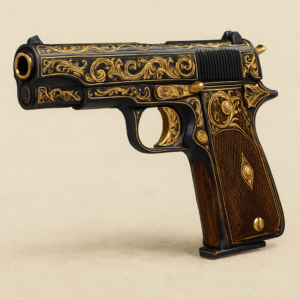Key Takeaways:
- German firearms aren’t just weapons—they’re history you can hold: From the elegant toggle-lock of the Luger P08 to the polymer-framed G36, each of these firearms represents a specific moment in time. They reflect how German engineering evolved through war, reconstruction, and innovation, not just to meet the needs of soldiers, but to redefine what firearms could be.
- Form followed function, but never at the cost of finesse: Whether it was the MG42’s terrifying efficiency or the MP5’s refined control, German guns balanced brutal functionality with precision craftsmanship. They weren’t overdesigned showpieces—they were tools built to work in mud, blood, and chaos—and still managed to feel like mechanical art.
- The legacy lives on—in armies, collections, and pop culture: These firearms didn’t fade with time. Many are still in service today, or live on through their descendants. Others became pop culture icons, showing up in movies, games, and stories passed down through generations. They’re not just important—they’re unforgettable.
The Luger P08 – A Gun That Needs No Introduction
Let’s start with the obvious legend. If there’s one German pistol that even non-gun people recognize, it’s the Luger P08. You’ve seen it in war movies, documentaries, and probably in the hands of every movie villain from the ’60s to the ’80s. But this gun’s story isn’t just about looks—it’s about what made it iconic.
Designed by Georg Luger at the turn of the 20th century, this pistol wasn’t just another sidearm—it was a mechanical marvel. That strange, almost insect-like toggle-lock on top? It’s not just for show. It’s a jointed mechanism that flips up and down as the gun cycles, giving the Luger a rhythm and motion all its own. In a world of simple blowbacks and hammer-fired designs, the P08 felt like a clockwork watch compared to a digital timer—complex, sure, but also elegant.
Adopted by the German military in 1908, it became more than just a tool of war. It was a symbol of German discipline and design. Chambered in 9mm Parabellum—a cartridge Luger himself helped create—the P08 combined firepower with surprisingly good ergonomics. It fits in the hand like it was meant to be there. Not too heavy, not too light. Balanced.
And make no mistake: this thing was accurate. Soldiers loved it for its portability, and officers flaunted it with pride. It became so culturally ingrained that even Allied troops would grab them off the battlefield as war trophies. Owning a Luger wasn’t just about having a gun—it was like holding a piece of military folklore.
Today, collectors obsess over variants, serial numbers, proof marks, and that satisfying clack of the toggle when you rack it. Some chase the early “Artillery” models with long barrels and shoulder stocks; others hunt for wartime captures with original holsters. Either way, the P08 remains more than a relic—it’s a bridge between artistry and warfare.
The Mauser K98k – The Workhorse With a Sniper’s Soul
Ask any WWII historian to name a rifle that defined the German infantry, and the answer is almost always the same: the Karabiner 98k. Shortened to K98k, this bolt-action rifle wasn’t flashy, but it was dependable, like an old friend who never let you down, even in the worst weather imaginable.
Now, let’s set the scene. It’s 1935. The German military needed something modern—something compact enough for mobile warfare, but still powerful enough to stop threats ata distance. Enter: the K98k. It took the already-proven Mauser 98 system and trimmed it down for quicker handling. The result was a shorter, more agile rifle that packed the same punch.
And when I say “punch,” I mean the 7.92x57mm Mauser cartridge. This thing hit hard. Whether it was across the frozen steppes of Russia or deep in the African deserts, the K98k held its own. The bolt-action system? Butter-smooth. It could take abuse, dirt, and freezing rain without jamming—something you couldn’t say about every weapon of the era.
But here’s the twist: despite being a rugged infantry rifle, it also had sniper DNA. With a scope mounted, the K98k turned into a fearsome long-range weapon. And post-war? It didn’t just fade into obscurity. Civilian hunters, competitive shooters, and even other armies started adapting the design. Heck, its action still serves as the foundation for a ton of modern hunting rifles today.
Collectors chase them now—not just because they’re historically important, but because the damn things still shoot like a dream. It’s rare to find something built for war that still feels elegant 80 years later.
The MP40 – German Steel Meets Urban Combat
You ever hear that distinctive “clack-clack-clack” in a WWII documentary and think, “What the hell is that?” Chances are, it’s the MP40. This wasn’t some heavy, crew-served machine gun—it was the street-smart submachine gun, built for mobility, not muscle.
Designed in the late 1930s by Heinrich Vollmer, the MP40 was Germany’s answer to the need for a lightweight automatic weapon for close-quarters battle. Think house-to-house fighting, clearing bunkers, or dropping into enemy territory as a paratrooper. For all of that, you needed something fast, compact, and easy to handle. The MP40 checked every box.
Chambered in the same 9mm Parabellum as the Luger, it simplified logistics. Ammo was shared, mags were swappable, and training didn’t need to reinvent the wheel. But more than that, the MP40 introduced one very practical innovation: a folding stock. No, it wasn’t the first gun to have one, but it made the idea mainstream. Soldiers could sling it, jump out of a plane, and unfold it in seconds. Smooth.
What’s wild is how controllable it was. Unlike some submachine guns of the era that felt like angry jackhammers, the MP40 had a relatively low cyclic rate—around 500–550 rounds per minute, which meant you could actually aim it. That matters when you’re not just spraying and praying.
It was also a product of mass production innovation. Stamped steel parts, simplified components—it wasn’t made to impress, it was made to work. And it worked brilliantly.
Even today, the MP40 shows up in museums, reenactments, and, of course, every other WWII video game. Its silhouette is unmistakable. And while it might not have had the raw firepower of a full rifle, in close quarters? It was exactly what the German infantry needed—and exactly what Allied soldiers feared when clearing a trench.
The MG42 – “Hitler’s Buzzsaw” and the Sound of Fear
If the Luger was sleek and refined, the MG42 was raw, unapologetic chaos. This thing didn’t whisper into combat—it screamed. With a rate of fire around 1,200 rounds per minute, the MG42 didn’t just shoot—it roared like a chainsaw tearing through steel. Troops on both sides had nicknames for it. The most infamous? “Hitler’s Buzzsaw.” And honestly, once you’ve heard it, you don’t forget it.
The Germans introduced the MG42 in 1942 to replace the more expensive, harder-to-produce MG34. War wasn’t just about strategy—it was about logistics. You needed weapons that could be churned out quickly and still function in mud, sand, snow—whatever the battlefield threw at you. The MG42 was that gun.
What made it terrifying wasn’t just its speed—it was the precision that came with it. It laid down suppressive fire with frightening efficiency. A single machine gun nest could pin down whole squads. But that blistering speed came at a cost: barrels overheated fast. So the engineers did something innovative—they built in a quick-change barrel system. Pop it out, slot in a new one, and you’re back in business.
Even after the war, the MG42’s influence didn’t stop. Countries adapted the design, including Germany itself. The MG3, still in use today, is basically an MG42 with a few modern tweaks. That’s staying power.
Collectors love it for the engineering. Veterans remember it for the sound. And historians? They respect it as one of the most mechanically brilliant, devastatingly effective weapons of the 20th century.
The Walther PPK – Sleek, Deadly, and… Bonded
Not all famous German firearms are battlefield brutes. Some, like the Walther PPK, made their mark in more subtle, stylish ways. Originally designed in 1931 for undercover police and civilian use, the PPK (Polizeipistole Kriminalmodell) is compact, elegant, and efficient. Think less “storm the trench,” more “slip it into your jacket.”
You know what’s funny? Despite its unassuming size, the PPK has a surprisingly deep resume. Law enforcement? Check. Military officers? Absolutely. Pop culture megastar? You bet—just ask James Bond.
Yes, this is the pistol that became synonymous with 007. Thanks to Ian Fleming and a few clever prop choices in early Bond films, the Walther PPK gained worldwide fame not through conflict, but through charisma. The sleek lines, the small frame, the European sensibility—it fit the persona of a suave agent perfectly.
But beneath the Hollywood glamour, the PPK was all business. Chambered in .32 ACP (7.65mm Browning), it packed enough punch for self-defense while maintaining excellent concealability. More importantly, it was one of the first mass-produced pistols to feature a double-action/single-action trigger with a decocker. That meant you could safely carry it chambered and ready, which was a big deal at the time.
It wasn’t just elegant—it was reliable. The fixed barrel design gave it a touch of extra accuracy, and the blowback system was straightforward and sturdy. It was the kind of gun you could trust in a pinch, which is probably why it stayed in service across Europe for decades.
Today, whether you’re a movie buff or a serious firearms historian, the Walther PPK represents something rare: a weapon equally at home on a red carpet and a battlefield.
The G3 Rifle – Germany’s Post-War Powerhouse
After WWII, Germany was rebuilding—politically, economically, and yes, militarily. And when the new Bundeswehr needed a service rifle that could stand with NATO’s best, they didn’t dust off old blueprints. Instead, they brought in Heckler & Koch, who, in the late 1950s, unveiled what would become one of the most widely used battle rifles of the Cold War: the G3.
On paper, it ticked all the right boxes: 7.62x51mm NATO chambering, robust construction, and serious stopping power. But the real magic? That roller-delayed blowback system. It sounds technical, but here’s the deal—it gave the rifle a smooth recoil impulse and reliable cycling in environments that would choke lesser guns. Rain, sand, snow—it didn’t care. The G3 just worked.
And you could fix it in the field. Everything about the design was built with practicality in mind. Take it apart quickly. Clean it easily. Swap out parts without needing a toolbox the size of a suitcase.
Soldiers loved it. So did police forces, border guards, and dozens of militaries around the world. From Norway to Nigeria, you’d find the G3. And even today, in places with fewer resources, it’s still being fielded—and still holding its own.
It wasn’t flashy, but it was damn good. And it laid the groundwork for a long line of Heckler & Koch rifles that followed. If the K98k was Germany’s WWII workhorse, the G3 was its Cold War evolution, just with a much bigger bite.
The MP5 – The Gold Standard of Submachine Guns
Now, imagine if the G3 and the PPK had a baby. That’s kind of how the MP5 came to be. Developed in the 1960s by Heckler & Koch, the MP5 took the G3’s roller-delayed magic and downsized it into a compact 9mm package—and the result was one of the finest submachine guns ever made.
This wasn’t just another 9mm spray-and-pray gun. The MP5 was smooth, stable, and ridiculously accurate for a subgun. It didn’t buck or rattle; it flowed. Put a burst into a tight group at 25 meters? Easy. Suppressed version that stays whisper-quiet during CQB ops? Done. It wasn’t just versatile—it was surgical.
No surprise, then, that elite units latched onto it. British SAS, German GSG 9, U.S. Navy SEALs—if there was a hostage situation or a counter-terror raid, odds were someone was running an MP5. It wasn’t just about reliability (though it had that in spades)—it was about control. Operators trusted it in tight rooms and high-stakes missions, where every shot had to count.
Pop culture grabbed it, too. You’ve seen it in every 1980s action movie and nearly every video game involving SWAT teams or secret agents. The silhouette, the classic curved mag, the three-lug suppressor-ready barrel—it’s unmistakable.
And while newer compact rifles have edged in on the MP5’s territory in recent years, it’s still in active use around the world. Why? Because perfection is hard to replace.
The HK416 – Built for the Dirt, Loved by the SEALs
If the G3 was built for Cold War battlefields, the HK416 was built for modern, messy, real-world combat—where sand gets in your mags, rain soaks your gear, and a malfunction could cost lives. This rifle wasn’t born in a lab; it was born in frustration.
Here’s the backstory: U.S. forces had long relied on the M4 platform, which, while lightweight and familiar, had a bit of a reputation for jamming when things got gritty—literally. Enter Heckler & Koch, who saw an opportunity to blend the AR-15 platform’s modularity with their own gas piston tech, borrowed from the G36. The result? The HK416—a rifle that ran cleaner, cooler, and more reliably than anything in its class.
Chambered in 5.56x45mm NATO, the HK416 kept the ergonomics that operators already loved. The controls were familiar. The feel was familiar. But underneath? It was all H&K engineering. The short-stroke gas piston system reduced carbon build-up, and the beefed-up bolt and internals gave it serious durability.
The proof? This is the rifle the Navy SEALs used to take out Osama bin Laden. That’s not just a spec sheet—that’s a resume.
Tactical units around the globe adopted it, and not just for its guts. The rifle’s modular upper could be dropped onto existing M4 lowers, making it easier for agencies to transition without replacing entire arsenals. And with endless rail space for optics, lasers, grips, and lights, it could be tailored for everything from urban raids to rural patrols.
Even civilian shooters love it—when they can get one. Semi-auto versions (the MR556) offer the same rock-solid performance in a package built for range days and competition. Simply put, the HK416 doesn’t try to reinvent the rifle—it just fixes everything people hated about the ones that came before.
The PSG1 – Sniper Precision with German Swagger
There’s a certain poetry in a weapon that can end a threat with one shot at 800 meters—and do it quietly, cleanly, and without fuss. That’s the PSG1. It’s not the kind of rifle you see in war films with blazing firefights. This is the rifle you never saw coming.
Heckler & Koch built the PSG1 in the early 1980s for one very specific job: precision shooting in high-stakes counter-terrorism missions. The Munich Olympics massacre in 1972 had left a deep scar, and police units needed a sniper rifle that could deliver surgical accuracy under pressure. Enter: Präzisionsschützengewehr 1.
Built on a heavily modified G3 platform, the PSG1 didn’t look like a battlefield rifle. It looked like something you’d find in a vault—because, honestly, it kind of belonged there. Free-floating heavy barrel. Match-grade trigger. Adjustable cheekpiece and buttstock. It was so customizable, it felt like it belonged in a tailor’s shop, not an armory.
And it was absurdly accurate. We’re talking sub-MOA groups at ranges beyond 600 meters, out of a semi-automatic rifle. That wasn’t just impressive—it was revolutionary for the time. It gave elite teams the speed of follow-up shots without sacrificing precision, which mattered when a split-second decision meant saving a hostage’s life.
Of course, the PSG1 came with a price tag to match. It was expensive—eye-wateringly so. But for teams that needed the best, cost wasn’t the point. Reliability and accuracy were.
Today, the PSG1 is more of a collector’s prize than a frontline tool. Newer rifles have taken their place in modern arsenals, but none quite match their aura. When you hold a PSG1, you’re not holding a gun. You’re holding a declaration: that accuracy isn’t optional—it’s everything.
The G36 – Germany’s High-Tech Leap Into the Future
By the early 1990s, the world had changed. The Cold War was over, NATO was evolving, and militaries needed rifles that could do more than just shoot—they needed to adapt, communicate, and survive in complex modern battlespaces. The old G3, for all its virtues, had grown long in the tooth. So Heckler & Koch got to work on something leaner, lighter, and far more flexible. What they came up with was the G36.
At first glance, it looked… different. Gone was the all-metal heft of the past. In its place? Polymer. Lots of it. Lightweight, corrosion-resistant, and surprisingly tough, the G36’s frame broke from tradition and embraced the future. But it wasn’t just a gimmick—this design made it far easier for troops to maneuver with the rifle during long patrols or fast-paced urban operations.
Chambered in 5.56x45mm NATO, the G36 offered familiar performance, but it wrapped it in some clever features. The dual-sight system—a reflex red dot on top of a 3.5x scope—meant you could engage at close range or stretch out a little further without swapping optics. That was a big deal in the days before red dots became standard issue.
Another big plus? Modularity. Different barrel lengths, stocks, and handguards let the G36 fill multiple roles—whether it was a compact carbine for CQB, a standard infantry rifle, or even a light support weapon with a drum mag and bipod.
It wasn’t perfect. There were some well-publicized overheating issues in sustained fire situations, especially in desert climates. But H&K responded with updates and variations, and the rifle remained the mainstay of the Bundeswehr for over two decades.
Beyond Germany, the G36 has been adopted by over 40 countries. That’s not a fluke. It was the right gun at the right time—fast, smart, and built for a world where digital communications and GPS mattered just as much as ballistics.
And just like that, Germany had proven—again—that it wasn’t just about making good guns. It was about making guns that fit the moment.
Conclusion – More Than Metal and Powder
So, what do these ten firearms really tell us?
Sure, they’re impressive on a technical level. You’ve got revolutionary bolt systems, early examples of modular design, and a whole lot of forward-thinking mechanics. But strip away the jargon and blueprints, and what you’re left with is this: Germany didn’t just make weapons. They made moments. They made history.
From the precise clack of a Luger toggle to the thunderous roar of the MG42, each firearm was more than a tool—it was a statement. Some reshaped wars. Others reshaped culture. A few did both.
And they weren’t all designed for the same purpose. Some were built in times of total war, when production speed was life or death. Others were crafted for peacetime security forces or elite special operators. But in every case, you’ll find the same traits baked into the metal: precision, durability, and an unrelenting drive to engineer something just a little better than what came before.
Even now, decades later, these guns still echo. They live on in modern derivatives, in civilian ranges, in collector safes, and yes—in the imaginations of millions who grew up reading about them, seeing them in films, or watching them in action on distant battlefields.
So whether you’re a military historian, a technical nerd, or just someone who appreciates the feel of finely-machined steel—German firearms offer a masterclass in what happens when design meets discipline.
And let’s be honest… they’re just damn cool, too.
Frequently Asked Questions
Honestly? It’s part engineering marvel, part historical artifact. That toggle-lock action is unlike anything else, and the pistol feels good in the hand, balanced and smooth. Add in its deep ties to both World Wars and its sheer cultural recognition, and it’s easy to see why collectors chase them with such passion.
Oh, absolutely. Its rate of fire—about 1,200 rounds per minute—gave it a sound like a buzzsaw, hence the nickname “Hitler’s Buzzsaw.” It could pin entire squads down with pure volume. Even Allied soldiers reported being shaken just by hearing it fire. And it wasn’t just loud—it was efficient, reliable, and deadly accurate for a machine gun.
Unsurprisingly well. Despite being over 50 years old, the MP5 remains in service with elite units around the world. Its roller-delayed system gives it unmatched control and accuracy in close quarters. Sure, newer guns are lighter or have more modularity, but the MP5 remains a gold standard because it simply works, and works well.
Think of it as evolution. The G3 was a full-powered battle rifle with a serious kick, built for Cold War infantry combat. The HK416, on the other hand, is a modern 5.56mm rifle designed to fix the reliability issues of older AR platforms. It’s smoother, more modular, and built for today’s fight, not yesterday’s.
Yes, several are—either directly or in modernized versions. The MG42 lives on as the MG3. The G3 still sees use in some nations. The MP5, G36, and HK416 are standard issue in military and police units worldwide. Even if the originals aren’t still fielded, their DNA shows up in today’s rifles and carbines.



